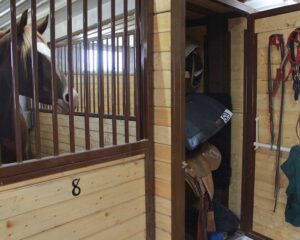


Barn Goals
5 steps to ‘stable-ize’ your stable
By Johi Kokjohn-Wagner
Barns often provide both a home for horses and a haven for their humans. To enhance the experience for both horse and rider, barn design requires the same thoughtful intention as home design. “Form follows function” is stalwart regarding barn interiors, demonstrated through lighting, safety, accessibility, space planning and visual impact. Horses benefit both mentally and physically from a well-designed stall, just as we do from a properly kept tack room and carefully planned use of space.
Raptor Ridge Ranch in Loveland, Colorado, consists of 326 acres of hay ground and equestrian facilities nestled against the foothills of the Rocky Mountains. When Bill and Anne Wheeler purchased the 1915 former dairy farm in 2013, they not only bought the property and buildings, but also took on years of deferred maintenance. Intending on using the acreage as a grass-fed bison farm, their plans soon took a turn toward hay and a riding academy, managed by their youngest daughter, Kristen.
Throughout the past three years, they’ve made improvements around the scenic ranch, with a large focus on the main horse barn that consists of office space, an indoor arena and about 45 stalls. The barn, built in the mid 1980s, provided plenty of physical space for horses, but lacked thought in the areas of functionality, ventilation and organization. With the help of a local builder (and fellow horse owner), Bill and Anne transformed the harvest gold, stuffy structure into something truly remarkable.
“Changes for safety, health and maintenance were primary drivers of the design,” Bill said.
Aesthetically, the barn was updated with new siding, roof, LED lighting and skylights. Structurally, the barn was stabilized with trusses in the indoor arena. Bill spoke of five different specific areas of improvement, which are fundamental to any barn planning:
1. Easy Stall Access
The Wheelers replaced the existing stalls with custom-designed pine-and-powder-coated metal stalls, each a spacious 12’ x 14’. The doors on the old stalls proved troublesome; the changing Colorado temperatures affected the slider rails, often making them difficult to use and lock. The new doors mount on roller wheels and secure with a pin on a chain instead of a standard latch. Neither the wheels nor the pin are affected by extreme heat or cold, making the stalls a breeze to open and close.
2. Water & Drainage
In the original barn, all of the individual stall waterers were controlled by one water valve, making any water repair a drought crisis. The old water pipes were also in the wall, requiring a carpenter to repair the stalls after a plumber had tended to leaks. After dealing with frozen pipes, the Wheelers installed a new water system, including automatic tanks fed by exposed pipes. Each stall is equipped with its own shut-off valve for quick and inexpensive repairs.
The topography of Raptor Ridge is sloping, and the main barn had a history of flooding. The Wheelers reshaped the terrain around the barn, added rock bedding topped with crushed concrete for mud and flood resistance.
 3. Inventive Tack Storage
3. Inventive Tack Storage
While the Wheelers’ barn does contain a spacious tack room, it also now provides each client with a private tack locker located on the corner of their stalls. Much like a modern horse trailer, the locker consists of swing-out saddle racks, a blanket bar, a shelf and hooks. With many convenient cross ties available, these lockers eliminate the need to lug heavy saddles through the barn. They also provide secure areas to store that expensive tack and reduce the risk of overbuying because something was lost in a community tack room.
4. Proper Footing & Ventilation
The indoor arena was formerly a problem area at Raptor Ridge. It was either too cold or too hot, often too dusty and stuffy. The Wheelers reassessed the ventilation system, adding suction fans to the outside and Big Ass Fans on the ceiling for better circulation. They are currently researching footing options for better dust control to make riding more enjoyable, not only for the horses and equestrians, but also for proud parents watching on the sidelines.
The stalls sport a solid piece of permeable floor material over three inches of sand, cut to the size of each stall and held in place by baseboards, eliminating slipping mats and uneven flooring. Each stall is filled with renewable fiber “soft bedding” and cleaned daily.
5. Thoughtful Organization
The Wheelers’ new barn design considers the needs of its horses and their humans. The two feed rooms consist of separated storage bins for grain, supplements and instructions. There are wash bays and saddling areas with emergency exits. The entry boasts restrooms, a kitchen, a viewing area and office spaces. The Wheeler barn is a perfect example of “a place for everything and everything in its place.”
Through intentional design, from the visual consistency of materials used to the functional availability of electricity by each cross tie, the Wheelers’ barn is a noteworthy and inspiring structure. The result is a beautiful, efficient, well-organized space full of happy horses and satisfied clients.
SHARE THIS